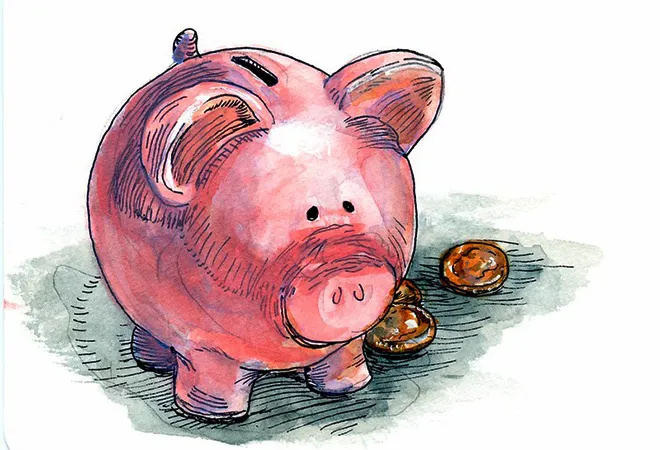
Economists belabour the point that emerging out of the pandemic–induced economic downturn is qualitatively different from emerging out of a long–drawn economic recession — simply put, it is easier to get back to where you were.
Turning on a light switch and flooding a dark room with light instantly is apt for describing what happens once health security–related lockdowns and movement restrictions are relaxed. Dormant economic engines thrum near instantly as economic agents — business, workers, financiers — get back to earning a living. This is the underlying assumption of the 10 percent real growth envisaged for India in 2021–22.
“Nanny economies” — which over–protect citizens, as in Europe and more recently, also in the United States, where the Biden administration unleashed a fiscal stimulus equaling 25 percent of the GDP — might have overplayed their hand. The massive publicly funded income boosters (doles) have bought hearts. But it will cost them heavily once debt servicing starts to bite into future fiscal resources.
Dormant economic engines thrum near instantly as economic agents — business, workers, financiers — get back to earning a living. This is the underlying assumption of the 10 percent real growth envisaged for India in 2021–22.
The economic justification for this fiscal indulgence is that private consumption, financed by doles, is a better economic booster than state directed capital expenditure, which anyway takes time to filter down. Publicly boosted private consumption can only be temporary. The conundrum is no one knows how long we must wait till jobs come back.
The job crunch is a long–term structural deficit, related to more than just the pandemic–related economic downturn. It is a consequence of technological disruption reducing the cost of capital versus the cost of labour — the minimum living standards approach is not a free ride — made worse by the tax bias for capital. Demography is increasingly less relevant for growth. On the supply side, productive human longevity has been extended by medical advances, whilst open global markets provide the necessary demand pull.
India dealt the few cards it held very well, whilst negotiating this extended period of fiscal stress. The sagacity of a cautious loosening of the fiscal deficit (FD) to 9.5 percent of GDP in the just ended fiscal 2020–21 (versus the target of 3.5 percent) and a sharp pullback next fiscal to 6.8 percent of GDP must be seen in the context of the public debt burden already increasing to 90 percent of GDP, the continuing long–term stagnation in the ratio of tax revenues to GDP and the uncertainty around future growth prospects.
The conundrum is no one knows how long we must wait till jobs come back.
Union tax receipts from October 2020 to February 2021 show a buoyancy of 25 percent over the same period in 2019–20. Projecting this tax buoyancy forward to 2021–22 creates the false hope that tax receipts could be higher than the budgeted INR 15.45 trillion.
Sadly, however, two–thirds of this observed buoyancy was due to increased excise duties on petroleum products. That option has played itself out. Retail fuel prices are at draconian highs versus the underlying cost of oil. This was bearable as a short–term emergency, revenue enhancement measure. But it is neither politically sustainable nor desirable, given the cost push impact on inflation.
The government, this week, confirmed continuation of the existing median inflation target of 4 percent within the band of 2 to 6 percent.
Reducing excise duty rates on fuel can knock–off around 0.5 percent of retail inflation which remained above 6 percent from December 2019 to October 2020 — admitted partly due to pandemic related supply disruptions after March 2020 — and was 5 percent in February 2021, thereby putting the brakes on low interest rate led growth.
Retail fuel prices are at draconian highs versus the underlying cost of oil.
The 2021–22 budget implicitly recognises the need to reduce excessively high excise duty rates and accounts for a reduced receipt of excise duties at INR 3.35 trillion this fiscal versus INR 3.6 trillion in the just concluded fiscal 2020–21.
Possibly, finding no joy in the potential for significantly enhancing tax revenue receipts, the budget speech (current fiscal) emphasised the need to enhance non–tax revenue through monetisation of existing public assets and the levy of user charges. Non–tax revenues (NTR) accounted for just 20 percent of total revenue receipt in 2019–20. Sadly, the fizz around monetisation has not translated into hard budgetary targets. The target for NTR in 2021–22 has slipped to just 13.6 percent of total revenue. In nominal terms, it is 26 percent lower than in 2019–20.
It is the same story for disinvestment — other capital receipts. The revised target for 2020–21 was just INR 0.33 trillion versus the actual receipt in the previous year of INR 0.5 trillion. At a time when the stock market has scaled new heights, this shortfall is puzzling. Despite the froth in the budget speech around privatisation, budgeted receipts at INR 1.75 trillion for this fiscal are lower than the INR 2.1 trillion targeted last year.
Monetisation and privatisation of public assets are significantly insulated from such near–term shocks.
With the pandemic continuing to play out through secondary regional waves, economic disruptions could constrain tax revenue receipts. Monetisation and privatisation of public assets are, however, significantly insulated from such near–term shocks. They derive their value from medium–term growth trends, which remain reasonably upbeat for India — a reversion to real growth of 6 to 7 percent from 2023 onwards.
Reducing the FD to 6.8 percent, this fiscal will depend crucially on the extent to which non–tax revenue receipts contribute to the INR 6 trillion required to achieve that objective. As budgeted presently, non–tax revenue receipts contribute less than one half at INR 2.4 trillion. This is clearly insufficient.
The prospects for revenue receipts remains uncertain. This calls for continued caution in revenue expenditure whilst privileging capex. Fiscal management, during the just concluded fiscal 2020–21 reflected this steely resolve. By the end of February 2021, Capital expenditures (CapEX) execution levels are at 92.4 percent of the targeted INR 4.38 trillion whilst for revenue expenditure it is lower at 80.1 percent of the targeted INR 30.12 trillion.
Migration streams are a value enhancing national network, much like roads, telecom, or energy grids. They make labour markets efficient.
This fiscal will not be an easy ride. Jobs remain at risk and earnings even more so. If physical disruptions related to the pandemic continue, government might have to enhance the budgeted outlays on social protection, including some version of temporary income enhancement benefits, along the template of the direct cash transfers for 70 million farmers.
40 million inter–state urban migrant workers in the informal sector are a special class of new beneficiaries for social protection provided directly by the Union Government. Their home states value their votes but are limited by the extent of their mandate. The receiving states view them as economically beneficial but accept no long–term social responsibility.
Migration streams are a value enhancing national network, much like roads, telecom, or energy grids. They make labour markets efficient. The Union government is best placed to regulate trans–state boundary flows as in the case of goods, capital, or crime.
Keeping the gates open for migratory workers against perverse localisation pressures — as seen recently in several states — is crucial for preserving the efficiency of labor markets. The Union Ministry of Labour and Employment must step in to “nudge” recalcitrant states, through incentives, to align with the theology of “one country, one market.”
The views expressed above belong to the author(s). ORF research and analyses now available on Telegram! Click here to access our curated content — blogs, longforms and interviews.



 Economists belabour the point that emerging out of the pandemic–induced economic downturn is qualitatively different from emerging out of a long–drawn economic recession — simply put, it is easier to get back to where you were.
Turning on a light switch and flooding a dark room with light instantly is apt for describing what happens once health security–related lockdowns and movement restrictions are relaxed. Dormant economic engines thrum near instantly as economic agents — business, workers, financiers — get back to earning a living. This is the underlying assumption of the 10 percent real growth envisaged for India in 2021–22.
“Nanny economies” — which over–protect citizens, as in Europe and more recently, also in the United States, where the Biden administration unleashed a fiscal stimulus equaling 25 percent of the GDP — might have overplayed their hand. The massive publicly funded income boosters (doles) have bought hearts. But it will cost them heavily once debt servicing starts to bite into future fiscal resources.
Economists belabour the point that emerging out of the pandemic–induced economic downturn is qualitatively different from emerging out of a long–drawn economic recession — simply put, it is easier to get back to where you were.
Turning on a light switch and flooding a dark room with light instantly is apt for describing what happens once health security–related lockdowns and movement restrictions are relaxed. Dormant economic engines thrum near instantly as economic agents — business, workers, financiers — get back to earning a living. This is the underlying assumption of the 10 percent real growth envisaged for India in 2021–22.
“Nanny economies” — which over–protect citizens, as in Europe and more recently, also in the United States, where the Biden administration unleashed a fiscal stimulus equaling 25 percent of the GDP — might have overplayed their hand. The massive publicly funded income boosters (doles) have bought hearts. But it will cost them heavily once debt servicing starts to bite into future fiscal resources.
 PREV
PREV


